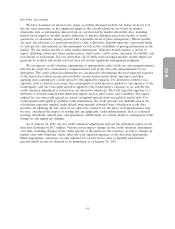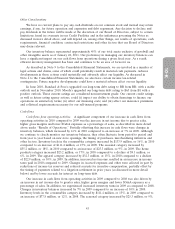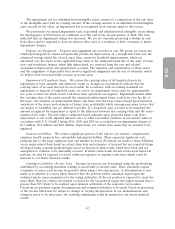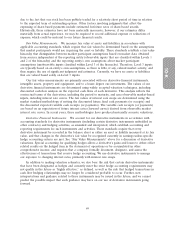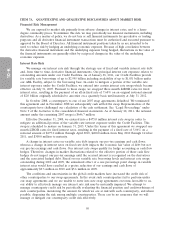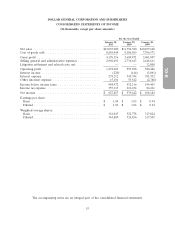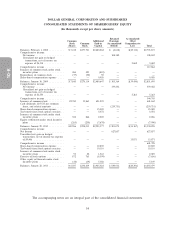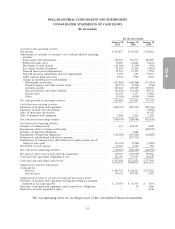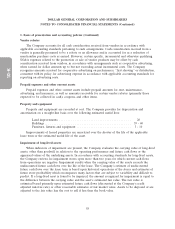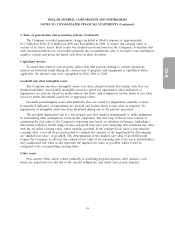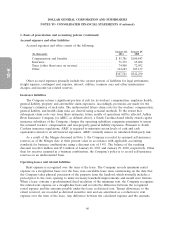Dollar General 2010 Annual Report Download - page 128
Download and view the complete annual report
Please find page 128 of the 2010 Dollar General annual report below. You can navigate through the pages in the report by either clicking on the pages listed below, or by using the keyword search tool below to find specific information within the annual report.
10-K
ITEM 7A. QUANTITATIVE AND QUALITATIVE DISCLOSURES ABOUT MARKET RISK
Financial Risk Management
We are exposed to market risk primarily from adverse changes in interest rates, and to a lesser
degree commodity prices. To minimize this risk, we may periodically use financial instruments, including
derivatives. As a matter of policy, we do not buy or sell financial instruments for speculative or trading
purposes and all derivative financial instrument transactions must be authorized and executed pursuant to
approval by the Board of Directors. All financial instrument positions taken by us are intended to be
used to reduce risk by hedging an underlying economic exposure. Because of high correlation between
the derivative financial instrument and the underlying exposure being hedged, fluctuations in the value of
the financial instruments are generally offset by reciprocal changes in the value of the underlying
economic exposure.
Interest Rate Risk
We manage our interest rate risk through the strategic use of fixed and variable interest rate debt
and, from time to time, derivative financial instruments. Our principal interest rate exposure relates to
outstanding amounts under our Credit Facilities. As of January 28, 2011, our Credit Facilities provide
for variable rate borrowings of up to $2.995 billion including availability of up to $1.031 billion under
our ABL Facility, subject to the borrowing base. In order to mitigate a portion of the variable rate
interest exposure under the Credit Facilities, we entered into certain interest rate swaps which became
effective on July 31, 2007. Pursuant to these swaps, we swapped three month LIBOR rates for fixed
interest rates, resulting in the payment of an all-in fixed rate of 7.68% on an original notional amount
of $2.0 billion originally scheduled to amortize on a quarterly basis until maturity at July 31, 2012.
In October 2008, a counterparty to one of our 2007 swap agreements defaulted. We terminated
this agreement and in November 2008 we subsequently cash settled the swap. Representatives of the
counterparty have challenged our calculation of the cash settlement. See ‘‘Legal Proceedings’’ under
Note 9 of the footnotes to the consolidated financial statements. As of January 28, 2011, the notional
amount under the remaining 2007 swaps is $646.7 million.
Effective December 31, 2008, we entered into a $475.0 million interest rate swap in order to
mitigate an additional portion of the variable rate interest exposure under the Credit Facilities. This
swap is scheduled to mature on January 31, 2013. Under the terms of this agreement we swapped one
month LIBOR rates for fixed interest rates, resulting in the payment of a fixed rate of 5.06% on a
notional amount of $475.0 million through April 2010, $400.0 million from May 2010 through October
2011, and $300.0 million to maturity.
A change in interest rates on variable rate debt impacts our pre-tax earnings and cash flows;
whereas a change in interest rates on fixed rate debt impacts the economic fair value of debt but not
our pre-tax earnings and cash flows. Our interest rate swaps qualify for hedge accounting as cash flow
hedges. Therefore, changes in market fluctuations related to the effective portion of these cash flow
hedges do not impact our pre-tax earnings until the accrued interest is recognized on the derivatives
and the associated hedged debt. Based on our variable rate borrowing levels and interest rate swaps
outstanding during 2010 and 2009, the annualized effect of a one percentage point change in variable
interest rates would have resulted in a pretax reduction of our earnings and cash flows of
approximately $9.3 million in 2010 and $5.6 million in 2009.
The conditions and uncertainties in the global credit markets have increased the credit risk of
other counterparties to our swap agreements. In the event such counterparties fail to perform under
our swap agreements and we are unable to enter into new swap agreements on terms favorable to us,
our ability to effectively manage our interest rate risk may be materially impaired. We attempt to
manage counterparty credit risk by periodically evaluating the financial position and creditworthiness of
such counterparties, monitoring the amount for which we are at risk with each counterparty, and where
possible, dispersing the risk among multiple counterparties. There can be no assurance that we will
manage or mitigate our counterparty credit risk effectively.
50



